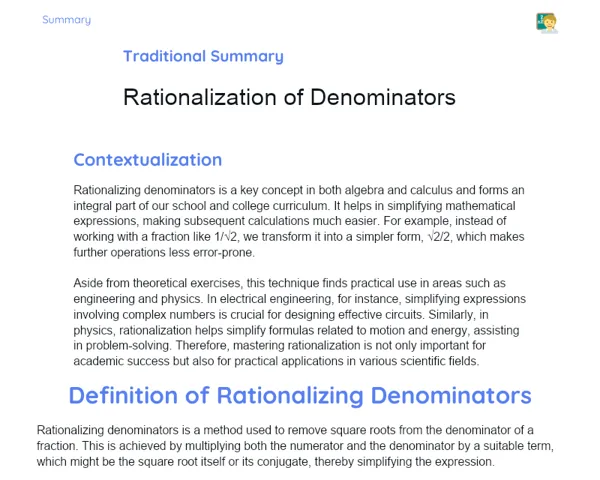Summary Tradisional | Scientific Notation
Contextualization
Scientific notation is a highly effective mathematical tool for expressing very large or very small numbers in a simplified manner. This notation is prevalent across various scientific fields such as physics, chemistry, and astronomy, where we frequently encounter quantities that range from subatomic sizes to vast interplanetary distances. Rather than writing lengthy numbers, scientific notation allows us to represent them as a product of a decimal number and a power of 10, making it easier to read, write, and understand numerical data.
For instance, the average distance from Earth to the Sun is approximately 149,600,000 kilometers. Writing this full distance can be unwieldy and prone to errors. Instead, using scientific notation, we can express it as 1.496 x 10^8 km. Similarly, the mass of an electron, which is exceedingly small, can be written as 9.11 x 10^-31 kg rather than 0.000000000000000000000000000000911 kg. This illustrates how scientific notation simplifies working with extreme numbers, making calculations more manageable while enhancing clarity and precision.
To Remember!
Definition of Scientific Notation
Scientific notation is a method of writing very large or very small numbers using powers of 10. A number in scientific notation is expressed as the product of a number that falls between 1 and 10 and a power of 10. This representation simplifies working with extreme numbers, making calculations and writing more straightforward. For example, rather than writing 1,000,000, we can express it as 1 x 10^6, thereby simplifying both reading and handling of the number.
This notation is especially useful in scientific contexts, where we often deal with measurements that span very broad orders of magnitude. In physical sciences, for instance, we frequently encounter sizes from subatomic particles to the vast distances between celestial bodies. Scientific notation offers a standardized way to manage these significant variations, aiding in comparison and data analysis.
A vital aspect of scientific notation is that it allows for a clear representation of a measurement's precision. By expressing a number in terms of its mantissa and exponent, we can indicate how many decimal places are significant, crucial for maintaining accuracy in scientific contexts.
-
Scientific notation employs powers of 10 to represent large or small numbers.
-
In scientific notation, a number is expressed as the product of a number between 1 and 10 and a power of 10.
-
It facilitates dealing with extreme numbers and is widely used in scientific contexts.
Structure of Scientific Notation
Scientific notation consists of two main parts: the mantissa and the exponent. The mantissa is a decimal number between 1 and 10, while the exponent is an integer that indicates the power of 10 by which the mantissa is multiplied. For example, in the expression 3.2 x 10^4, 3.2 serves as the mantissa and 4 is the exponent. This structure allows for a concise and precise representation of very large or very small numbers.
The mantissa always has to be a number that is greater than or equal to 1 and less than 10, ensuring standardized notation that makes comparing different numbers straightforward. The exponent can be either positive or negative. A positive exponent means the decimal point shifts to the right, while a negative exponent signifies the decimal point moves to the left.
This structure is key to the efficiency and utility of scientific notation. It allows calculations with extreme numbers to be executed more easily and with a reduced chance of errors, which is critical in various scientific and technical fields.
-
Scientific notation comprises a mantissa and an exponent.
-
The mantissa must be a decimal figure between 1 and 10.
-
The exponent indicates how the mantissa should be multiplied by powers of 10.
Converting Numbers to Scientific Notation
Converting a conventional number into scientific notation involves two critical steps: adjusting the decimal point and identifying the corresponding exponent. First, we shift the decimal point until we have a number between 1 and 10. The number of steps taken in this shift determines the value of the exponent. If the decimal moves left, the exponent is positive; if it moves right, it becomes negative.
For example, when converting 123,000 into scientific notation, we move the decimal 5 places to the left, arriving at 1.23 x 10^5. For a smaller number like 0.00056, moving the decimal 4 places to the right results in 5.6 x 10^-4. These processes ensure that the number is presented compactly and precisely, which aids in reading and calculations.
The practice of converting numbers to scientific notation is vital for managing numerical data across multiple scientific disciplines. It simplifies large data tables and allows for more efficient complex calculations, minimizing the risk of error.
-
Shift the decimal point to obtain a number between 1 and 10.
-
Establish the exponent based on how many positions the decimal was moved.
-
A positive exponent indicates the decimal moved left, while negative indicates it moved right.
Converting Scientific Notation to Common Numbers
To convert a number from scientific notation to a regular number, one must move the decimal point in line with the exponent's value. If the exponent is positive, the decimal shifts right; if it's negative, it moves left. This procedure reverses converting to scientific notation and is equally key in interpreting numerical data.
For example, converting 5.67 x 10^3 to a common number involves moving the decimal 3 spaces right, yielding 5670. Conversely, for a number like 4.2 x 10^-2, we shift the decimal 2 spaces left to get 0.042. These actions guarantee the numbers are expressed properly and accurately, making for reliable readings and interpretations.
Grasping the conversion from scientific notation to common numbers is critical across numerous disciplines, especially in fields with considerable numerical data. This understanding enables scientists and engineers to correctly interpret results and utilize this data in their analyses and computations.
-
Move the decimal point in accordance with the exponent's value.
-
For positive exponents, shift the decimal right.
-
For negative exponents, shift the decimal left.
Practical Applications of Scientific Notation
Scientific notation is extensively used across various branches of science and engineering due to its capacity to simplify the representation and computation of exceedingly large or small numbers. In physics, for instance, quantities such as the speed of light (approximately 3.00 x 10^8 m/s) or Planck's constant (6.626 x 10^-34 Js) are expressed using this notation, facilitating easier manipulation in complex calculations.
In chemistry, scientific notation is vital for representing atomic masses, solution concentrations, and other quantities with broad ranges. For instance, a hydrogen atom's mass is around 1.67 x 10^-27 kg, a figure that would be cumbersome without scientific notation. Likewise, in astronomy, this notation is employed for interplanetary and intergalactic distances, such as the gap between Earth and the nearest star, Proxima Centauri, which is roughly 4.24 x 10^13 km.
Beyond natural sciences, scientific notation finds utility in other sectors like economics and engineering, where large numbers are commonplace. For instance, in economics, it can denote the GDP of substantial nations, while in engineering, it's instrumental for detailing material properties or results from calculations of large-scale projects.
-
Utilized to simplify the representation and calculation of extreme numbers.
-
Crucial in subjects like physics, chemistry, and astronomy.
-
Also relevant in economics, engineering, and other fields.
Key Terms
-
Scientific Notation: A way to represent very large or very small numbers using powers of 10.
-
Mantissa: The portion of a number in scientific notation that is a decimal between 1 and 10.
-
Exponent: An integer in scientific notation indicating how many times the mantissa should be multiplied by 10.
-
Powers of 10: Repeated multiplications of the number 10, used to simplify the representation of numbers in scientific notation.
-
Conversion: The process of changing standard numbers into scientific notation and vice versa.
Important Conclusions
Scientific notation is an essential instrument for streamlining the representation and computation of notably large or small numbers, proving useful across many scientific disciplines. During the session, we delved into the definition and structure of scientific notation, learning how to identify the mantissa and exponent and understanding how these elements allow us to express numbers in a compact and precise way.
We also discussed how to convert common numbers to scientific notation and back, a crucial skill for handling numerical data in scientific environments, simplifying reading, writing, and calculations. Mastering these processes enables students to work more effectively with quantities spanning vast orders of magnitude.
The utilization of scientific notation in areas such as physics, chemistry, and astronomy underscores its practical significance. Being able to represent extreme numbers concisely is vital for analyzing and interpreting data in diverse fields of knowledge. We encourage students to keep exploring this subject to enhance their understanding and application in various contexts.
Study Tips
-
Practice converting common numbers into scientific notation and vice versa with varied examples to solidify the process and recognize patterns.
-
Investigate scientific disciplines such as physics, chemistry, and astronomy to see real-life applications of scientific notation. This will build a bridge between theory and practice.
-
Utilize online resources like educational videos and simulators to visualize the conversion process, aiding your understanding of scientific notation's significance in a scientific context.


